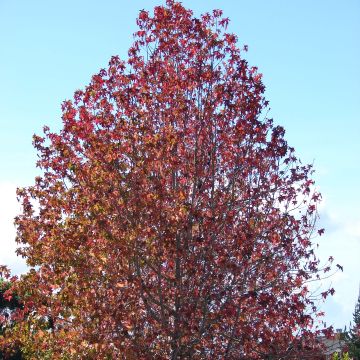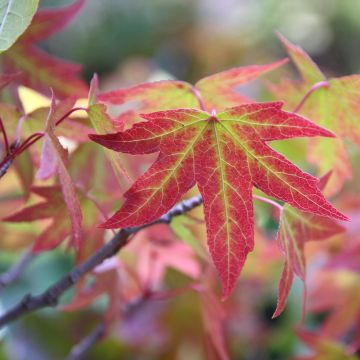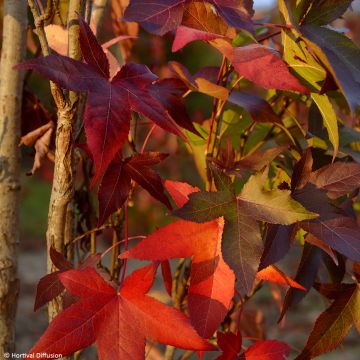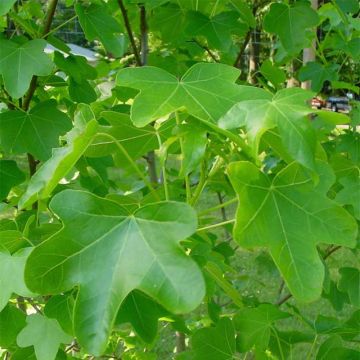

Liquidambar styraciflua Naree - American Sweetgum
Liquidambar styraciflua Naree - American Sweetgum
Liquidambar styraciflua Naree
American Sweetgum, Redgum, Satin-walnut, Alligator-wood
Special offer!
Receive a €20 voucher for any order over €90 (excluding delivery costs, credit notes, and plastic-free options)!
1- Add your favorite plants to your cart.
2- Once you have reached €90, confirm your order (you can even choose the delivery date!).
3- As soon as your order is shipped, you will receive an email containing your voucher code, valid for 3 months (90 days).
Your voucher is unique and can only be used once, for any order with a minimum value of €20, excluding delivery costs.
Can be combined with other current offers, non-divisible and non-refundable.
Why not try an alternative variety in stock?
View all →This plant carries a 24 months recovery warranty
More information
We guarantee the quality of our plants for a full growing cycle, and will replace at our expense any plant that fails to recover under normal climatic and planting conditions.
Would this plant suit my garden?
Set up your Plantfit profile →
Description
Liquidambar styraciflua 'Naree' is a variety of American sweetgum that is characterised by moderate growth and spring foliage in golden yellow, turning chartreuse green in summer, and adorned with shades of orange, yellow, and burgundy in autumn. This palmate foliage, reminiscent of some maples, with its changing colours throughout the seasons, is the main asset of this tree. Less bulky than the species, it is suitable for medium-sized gardens. It can be used in alignment or as a standalone to bring light and colour to slightly darker areas.
The American sweetgum is a tree of the witch-hazel family, which includes many beautifully coloured plants in autumn, such as witch-hazels, ironwoods, and loropetalums. This majestic tree is native to North America, specifically the banks of large rivers such as the Mississippi and Ohio. Its name, Liquidambar, comes from the Latin word "liquidus", meaning liquid, and the Arabic word "ambar", meaning amber, due to the aromatic amber-coloured resin that flows from its bark. Discovered in 1528, it was introduced to Europe in 1681.
The cultivar 'Naree' is a fairly compact variety that reaches an average height of 12 m (39.4 ft) in our gardens. Its growth rate is moderate. Over time, it develops a very vertical trunk topped with a fairly open crown, with a pyramidal habit, reaching a diameter of approximately 6 m (19.7 ft) at the base. In this variety, the lateral branches are harmoniously arranged perpendicular to the trunk. The deciduous foliage is the main asset of this tree. It consists of palmate leaves, 10 cm to 18 cm (3.9 in to 7.1 in) long, divided into 5 slender lobes, with the central lobe longer than the others. The finely toothed leaves are alternately arranged on the branches. They are golden yellow, then chartreuse in summer, and turn orange, yellow, and burgundy in autumn. The inconspicuous flowering occurs in April on trees aged 25 years and older, in the form of erect male catkins separate from the female flowers, in the form of pendant glomerules measuring 2 cm to 3 cm (0.8 in to 1.2 in) in diameter. After pollination, pompom-like fruits form, somewhat resembling those of plane trees. Each fruit consists of several capsules containing small winged seeds, similar to maple samaras. The bark of the sweetgum is dark brown, with cork-like crevices. The lifespan of this beautiful tree is approximately 150 years.
The 'Naree' sweetgum is perfectly hardy. This tree requires a non-calcareous, deep, and moist soil without being waterlogged, and a sunny exposure. Once established, it requires no maintenance. It can be planted either as a standalone tree on a large lawn or in alignment along a wide avenue or property boundary. Liquidambar styraciflua is commonly found in parks, where it stands out for its superb autumn colours. You can plant it with other colourful trees such as Ginkgo biloba, Nyssa sylvatica, large Japanese maples, and the bald cypress, which all thrive in similar cool environments and deep soils.
Properties:
The aromatic resin exuded by the bark is also called styrax or liquidambar balm. It was once used in aromatherapy, primarily by indigenous populations, and later, upon its arrival in Europe, by cosmetic manufacturers who incorporated it into various preparations such as milks and beauty creams. The wood of the sweetgum, with its reddish-brown colour, renowned for its scent and mechanical qualities, was widely used in cabinet-making for the production of furniture.
Liquidambar styraciflua Naree - American Sweetgum in pictures


Plant habit
Flowering
Foliage
Botanical data
Liquidambar
styraciflua
Naree
Hamamelidaceae
American Sweetgum, Redgum, Satin-walnut, Alligator-wood
Cultivar or hybrid
Other Liquidambar - Sweetgum
View all →Planting and care
Liquidambar styraciflua 'Naree' thrives in the sun, sheltered from strong winds. Plant in light, deep, preferably acidic, humus-rich and loamy soil that is moist but not waterlogged. It cannot tolerate chalky soil. When planting, mix your soil with 50% compost. Pruning is not necessary. Water regularly in the first few years to help it establish, and apply a basal fertiliser every spring. It is a disease and pest resistant tree.
Planting period
Intended location
Care
Planting & care advice
This item has not been reviewed yet - be the first to leave a review about it.
Haven't found what you were looking for?
Hardiness is the lowest winter temperature a plant can endure without suffering serious damage or even dying. However, hardiness is affected by location (a sheltered area, such as a patio), protection (winter cover) and soil type (hardiness is improved by well-drained soil).

Photo Sharing Terms & Conditions
In order to encourage gardeners to interact and share their experiences, Promesse de fleurs offers various media enabling content to be uploaded onto its Site - in particular via the ‘Photo sharing’ module.
The User agrees to refrain from:
- Posting any content that is illegal, prejudicial, insulting, racist, inciteful to hatred, revisionist, contrary to public decency, that infringes on privacy or on the privacy rights of third parties, in particular the publicity rights of persons and goods, intellectual property rights, or the right to privacy.
- Submitting content on behalf of a third party;
- Impersonate the identity of a third party and/or publish any personal information about a third party;
In general, the User undertakes to refrain from any unethical behaviour.
All Content (in particular text, comments, files, images, photos, videos, creative works, etc.), which may be subject to property or intellectual property rights, image or other private rights, shall remain the property of the User, subject to the limited rights granted by the terms of the licence granted by Promesse de fleurs as stated below. Users are at liberty to publish or not to publish such Content on the Site, notably via the ‘Photo Sharing’ facility, and accept that this Content shall be made public and freely accessible, notably on the Internet.
Users further acknowledge, undertake to have ,and guarantee that they hold all necessary rights and permissions to publish such material on the Site, in particular with regard to the legislation in force pertaining to any privacy, property, intellectual property, image, or contractual rights, or rights of any other nature. By publishing such Content on the Site, Users acknowledge accepting full liability as publishers of the Content within the meaning of the law, and grant Promesse de fleurs, free of charge, an inclusive, worldwide licence for the said Content for the entire duration of its publication, including all reproduction, representation, up/downloading, displaying, performing, transmission, and storage rights.
Users also grant permission for their name to be linked to the Content and accept that this link may not always be made available.
By engaging in posting material, Users consent to their Content becoming automatically accessible on the Internet, in particular on other sites and/or blogs and/or web pages of the Promesse de fleurs site, including in particular social pages and the Promesse de fleurs catalogue.
Users may secure the removal of entrusted content free of charge by issuing a simple request via our contact form.
The flowering period indicated on our website applies to countries and regions located in USDA zone 8 (France, the United Kingdom, Ireland, the Netherlands, etc.)
It will vary according to where you live:
- In zones 9 to 10 (Italy, Spain, Greece, etc.), flowering will occur about 2 to 4 weeks earlier.
- In zones 6 to 7 (Germany, Poland, Slovenia, and lower mountainous regions), flowering will be delayed by 2 to 3 weeks.
- In zone 5 (Central Europe, Scandinavia), blooming will be delayed by 3 to 5 weeks.
In temperate climates, pruning of spring-flowering shrubs (forsythia, spireas, etc.) should be done just after flowering.
Pruning of summer-flowering shrubs (Indian Lilac, Perovskia, etc.) can be done in winter or spring.
In cold regions as well as with frost-sensitive plants, avoid pruning too early when severe frosts may still occur.
The planting period indicated on our website applies to countries and regions located in USDA zone 8 (France, United Kingdom, Ireland, Netherlands).
It will vary according to where you live:
- In Mediterranean zones (Marseille, Madrid, Milan, etc.), autumn and winter are the best planting periods.
- In continental zones (Strasbourg, Munich, Vienna, etc.), delay planting by 2 to 3 weeks in spring and bring it forward by 2 to 4 weeks in autumn.
- In mountainous regions (the Alps, Pyrenees, Carpathians, etc.), it is best to plant in late spring (May-June) or late summer (August-September).
The harvesting period indicated on our website applies to countries and regions in USDA zone 8 (France, England, Ireland, the Netherlands).
In colder areas (Scandinavia, Poland, Austria...) fruit and vegetable harvests are likely to be delayed by 3-4 weeks.
In warmer areas (Italy, Spain, Greece, etc.), harvesting will probably take place earlier, depending on weather conditions.
The sowing periods indicated on our website apply to countries and regions within USDA Zone 8 (France, UK, Ireland, Netherlands).
In colder areas (Scandinavia, Poland, Austria...), delay any outdoor sowing by 3-4 weeks, or sow under glass.
In warmer climes (Italy, Spain, Greece, etc.), bring outdoor sowing forward by a few weeks.






















































